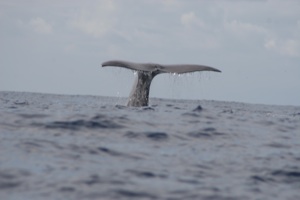A magazine where the digital world meets the real world.
On the web
- Home
- Browse by date
- Browse by topic
- Enter the maze
- Follow our blog
- Follow us on Twitter
- Resources for teachers
- Subscribe
In print
What is cs4fn?
- About us
- Contact us
- Partners
- Privacy and cookies
- Copyright and contributions
- Links to other fun sites
- Complete our questionnaire, give us feedback
Search:
Watching whales well

Sasha owns a new tour company and her first tours are to the Azores, a group of volcanic islands in the Atlantic Ocean, off the coast of Portugal. They are one of the best places in the world to see whales and dolphins, so lots of people are signing up to go.
Sasha’s tour as advertised is to visit all nine islands in the Azores: São Miguel, Terceira, Faial, Pico, São Jorge, Santa Maria, Graciosa, Flores and Corvo. The holidaymakers go whale watching as well as visiting the attractions on each island, like swimming in the lava pools. Sasha’s first problem, though, is to sort out the itinerary. She has to work out the best order to visit the islands so her customers spend as little time as possible travelling, leaving more for watching whales and visiting volcanos. She also doesn’t want the tour to go back to the same island twice – and she needs it to end up back at the starting island, São Miguel, for the return flight back home.
Trouble in paradise
It sounds like it should be easy, but it’s actually an example of a computer science problem that dates back at least to the 1800s. It’s known as 'The Travelling Salesman Problem' because it is the same problem a salesman has who wants to visit a series of cities and get back to base at the end of the trip. It is surprisingly difficult.
It’s not that hard to come up with any old answer (just join the dots!), but it’s much tougher to come up with the best answer. Of course a computer scientist doesn’t want to just solve one-off problems like Sasha’s but to come up with a way of solving any variant of the problem. Sasha, of course, agrees – once she’s sorted out the Azores itinerary, she then needs to solve similar problems, like the day trip round São Miguel. Her customers will visit the lakes, the tea factory, the hot spring-fed swimming pool in the botanic gardens and so on. Not only that, once Sasha’s done with the Azores, she then needs to plan a wildlife tour of Florida. Knowing a quick way to do it would help her a lot.

The long way round
No one has yet come up with a good way to solve the Travelling Salesmen problem though and it is generally believed to be impossible. You can find the best solution in theory of course: just try all the alternatives. Sasha could first work out how long it is if you go São Miguel, Terceira, Faial, Pico, São Jorge, Santa Maria, Graciosa, Flores, Corvo and back to São Miguel, then work out the time for a different order, swapping Corvo and Flores, say. Then she could try a different route, and keep on till she knew the length of every variation. She would then just pick the best. Trouble is, that takes forever.
Even this small problem with only 9 islands has over 20 000 solutions to check. Go up to a tour of 15 destinations and you have 43 billion calculations to do. Add a few more and it would take centuries for a fast computer running flat out to solve it. Bigger still and you find the computer would have to run for longer than the time left before the end of the universe. Hmmm. It’s a problem then.
Be greedy
The solution is not to be such a perfectionist and accept that a good solution will have to be good enough even though it may not be the absolute best. One way to get a good solution is called using a ‘greedy’ algorithm. You start at São Miguel and just go from there to the nearest island, from there to the nearest island not yet visited, and so on till you have done them all. That would probably work well for the Azores as they are in groups, so visiting the close ones in each group together makes sense. It doesn’t guarantee the best answer in all cases though.
Or just go climb a hill
Another way is to use a version of 'hill climbing'. Here you take any old route and then try and optimise it, by just making small changes – swapping pairs of legs over, say: instead of going Faial to Pico and later Corvo to Flores try substituting Pico to Flores and Faial to Corvo, with the rest the same but in the opposite order. If the change is an improvement keep it and make later changes to that. Otherwise stick with the original. Either way keep trying changes on the best solution you’ve found so far, until you run out of time.
So Sasha may want to run a great tour company but there may not be enough time in the universe for her tours to be guaranteed perfect...unless of course she keeps them very small. After all, just visiting São Miguel and Terceira makes a great holiday anyway.


